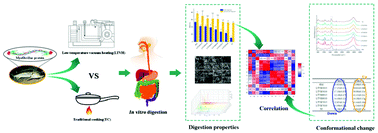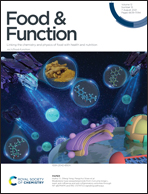Changes in the digestion properties and protein conformation of sturgeon myofibrillar protein treated by low temperature vacuum heating during in vitro digestion
Abstract
The digestion properties of sturgeon myofibrillar protein (MF) treated by low temperature vacuum heating (LTVH) at different processing temperatures (50, 60 and 70 °C) and times (15 and 30 min) were studied and compared with those of sturgeon MF treated by traditional cooking (TC). The results showed that as the temperature and time increased, the protein digestibility decreased, whereas the particle size and protein aggregation increased. It was observed that the band intensity of myosin heavy chain and myosin heavy chain 7 weakened; however, the band intensity of actin showed little change. MALDI-TOF-MS analysis revealed that the digested products of the samples treated by LTVH had a larger proportion of 750–1000 Da peptides than those treated by TC, which was consistent with the trend of the number of unique peptides identified in each group. Fourier transmission infrared (FT-IR) spectroscopy showed that the contents of α-helices and β-sheets exhibited negative and positive correlations with the temperature, respectively. Overall, compared to TC, LTVH can relieve the heat stress of protein conformation, reduce protein aggregation to improve the accessibility of the protein to digestive protease, and increase digestibility.



 Please wait while we load your content...
Please wait while we load your content...